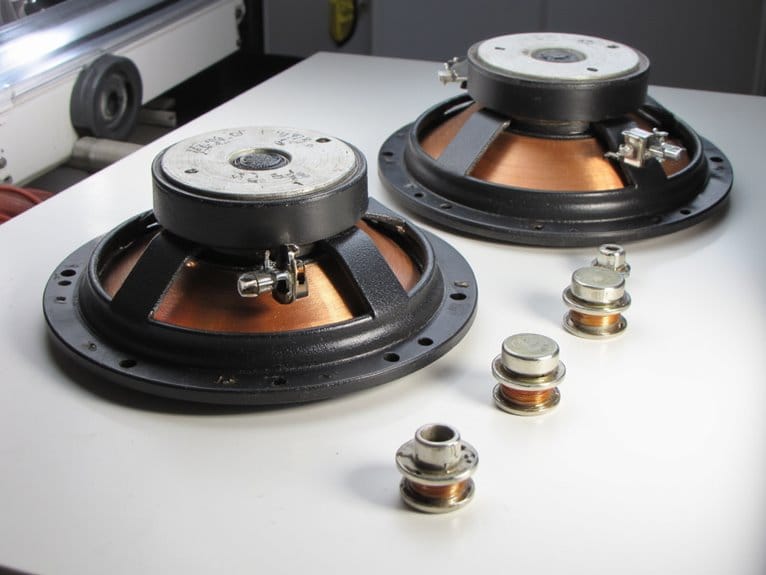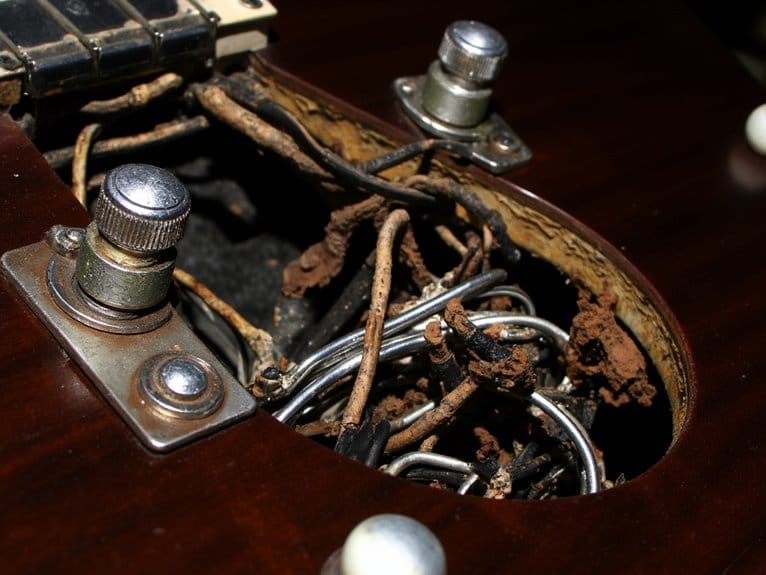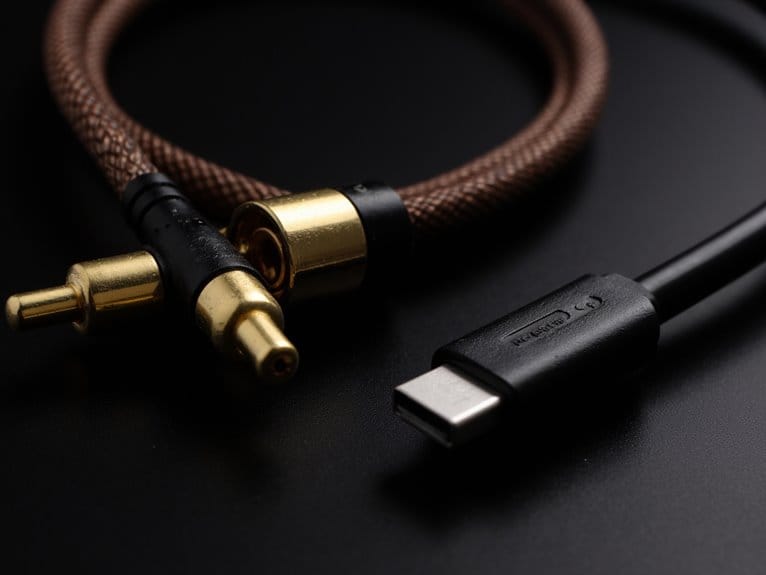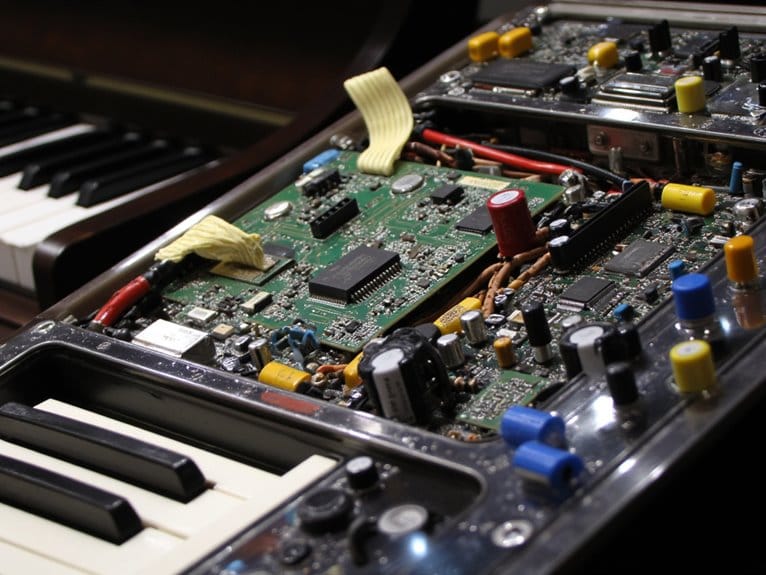Speaker and Load Combinations (Impedance Matching)
When you’re connecting speakers to amplifiers, you’ll need to match impedances-typically 4, 8, or 16 ohms-to guarantee ideal power transfer and prevent equipment damage. Lower impedance speakers draw more current, so your amplifier must handle the load without overheating. Parallel wiring decreases total impedance while series wiring increases it, affecting both power output and sound quality. Mismatched impedances create standing waves that waste power and degrade performance. Understanding these electrical relationships will reveal advanced techniques for professional installations.
We are supported by our audience. When you purchase through links on our site, we may earn an affiliate commission, at no extra cost for you. Learn more.
Notable Insights
- Speaker impedance (4, 8, or 16 ohms) must match amplifier specifications to ensure optimal power transfer and prevent equipment damage.
- Parallel wiring decreases total impedance while series wiring increases it, directly affecting power output and sound quality in multi-speaker systems.
- Mismatched impedances create standing waves that waste power, cause distortion, and can lead to amplifier overheating or failure.
- Audio transformers and DI boxes provide impedance conversion solutions, enabling proper matching between different audio components and signal types.
- Constant voltage systems in professional installations eliminate complex impedance calculations by using speaker transformers to match individual load requirements.
Understanding Speaker Impedance Ratings and Their Impact on Audio Systems
When I first started building audio systems, I’ll admit I thought speaker impedance was just another confusing spec that manufacturers threw around to make things complicated.
I used to think speaker impedance was just marketing jargon designed to confuse beginners like me.
But it’s actually one of the most critical factors that determines whether your setup will sound amazing or become an expensive lesson in mismatched components.
Speaker impedance, measured in ohms, represents the electrical resistance your speakers present to your amplifier, and it directly affects how much current flows through your system.
Different speaker types typically operate at 4, 8, or 16 ohms, with lower impedance demanding more current from your amp.
Getting this relationship right guarantees peak audio fidelity, while mismatches can lead to distortion, overheating, or even equipment damage that’ll have you questioning your life choices. The standard nominal impedance rating for most home theater equipment is 8 ohms, which provides a reliable baseline for component matching.
Active speakers handle impedance matching internally, eliminating the complexity of manual calculations and compatibility concerns.
Power Transfer Efficiency and Equipment Protection Through Proper Matching
After years of watching expensive amplifiers get fried by well-meaning enthusiasts who figured “close enough” was good enough for impedance matching, I’ve learned that proper power transfer isn’t just about getting the loudest sound-it’s about creating a harmonious electrical relationship that protects your investment while delivering peak performance.
When you achieve proper impedance matching, you’re fundamentally eliminating reflected power that would otherwise stress your amplifier’s output stages, causing overheating and potential failure. This load balancing guarantees your equipment operates within safe parameters while maintaining signal integrity throughout the audio chain.
Mismatched impedances create standing waves that waste power, degrade performance, and can generate distortion that damages both your amplifier and speakers over time. The reflection coefficient formula reveals how impedance mismatches lead to repeated reflections and energy loss throughout your audio system. This mismatch also slows down device response times during signal processing, affecting the clarity and accuracy of audio reproduction. Professional audio interfaces with proper impedance matching help prevent clipping by maintaining optimal gain settings throughout the signal path.
Just as quality cables feature dual-shield designs that minimize electromagnetic interference between components, proper impedance matching creates an optimal electrical environment that maximizes power efficiency while protecting your equipment investment.
Wiring Multiple Speakers: Parallel Vs Series Configurations
While impedance matching protects your gear, the way you wire multiple speakers together determines whether you’ll achieve that perfect electrical harmony or create a chaotic mess that’ll have your amplifier crying for mercy.
Understanding these connecting methods becomes essential when you’re dealing with multiple drivers.
Parallel wiring drops your total impedance considerably-two 8-ohm speakers become a 4-ohm load, delivering maximum power and superior sound quality.
However, adding more speakers creates wiring challenges since you’ll eventually hit your amp’s minimum impedance limit.
Series wiring does the opposite, adding impedances together while reducing power output and creating that thinner sound nobody wants. Series configurations often create crossover shifts that alter the intended frequency response when speaker load resistance changes.
Sure, it’s safer for your amplifier and cheaper to install, but one failed speaker kills your entire chain. The parallel configuration offers speaker redundancy, meaning if one speaker fails, the remaining speakers continue operating normally.
Impedance Matching Devices and Techniques for Audio Applications
A stubborn amplifier that won’t play nice with your speakers becomes surprisingly cooperative once you introduce the right impedance matching device into your signal chain.
Audio transformers represent the most reliable transformer applications, using turns ratios to create precise impedance relationships-a 15:1 ratio efficiently matches 120Ω amplifier outputs to 8Ω speakers while minimizing distortion.
DI boxes and buffer circuits excel at converting high-impedance instrument signals into balanced, low-impedance outputs that professional mixing consoles prefer, extending cable runs and reducing noise interference.
Passive matching networks using resistors, capacitors, and inductors create frequency-dependent solutions for complex speaker loads, though they require careful consideration of crossover components. Professional audio applications demand equipment stability to ensure reliable performance in demanding environments.
Multi-stage amplifiers benefit from coupling networks between stages, preserving gain while reducing signal degradation throughout the amplification process. Audio transformers provide electrical isolation between connected components, preventing ground loops and interference while maintaining signal integrity.
Professional Multi-Speaker Systems and Constant Voltage Solutions
Professional installations demand scaling beyond single speaker-amplifier pairs, where I’ve learned that managing multiple speakers across large venues requires fundamentally different approaches than home audio setups. You’ll encounter constant voltage advantages when dealing with distributed systems, as 70V and 100V lines eliminate complex impedance calculations across long cable runs. Speaker transformer roles become essential here, stepping down line voltage to match individual speaker requirements while allowing independent power adjustments through taps.
| System Type | Key Benefit |
|---|---|
| Low Impedance | Direct connection, higher fidelity |
| Constant Voltage | Simplified wiring, scalable design |
| Distributed Audio | Zone control, multiple sources |
I’ve found that proper SPL planning requires exceeding ambient noise by 6dB for announcements, while ceiling height directly influences speaker count and coverage patterns for ideal sound distribution. Large venue designs should ensure wavefront alignment by positioning speakers no more than 22 feet apart to maintain proper end-to-end timing across wall surfaces. When selecting speakers, prioritize units with consistent coverage across frequencies to improve overall performance and simplify equalization efforts.
On a final note
You’ve now got the foundation to make smart impedance decisions that’ll protect your gear and maximize performance. Whether you’re wiring speakers in series, parallel, or using matching transformers, remember that proper impedance matching isn’t just technical perfectionism-it’s practical insurance for your investment. I’ve seen too many blown amplifiers from mismatched loads, so take these principles seriously, measure twice, and you’ll enjoy clean, efficient audio for years.







